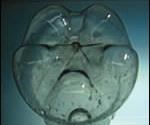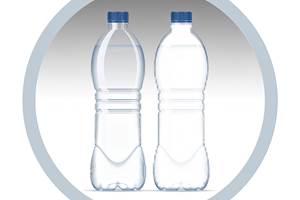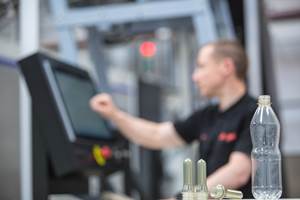PET Container Stress Cracking: Myth Versus Science
Since the introduction of the first 2-liter, one-piece PET bottle by Continental Can Co. in Fall River, Mass., in 1978, the PET container’s nemesis has been stress cracking.
Since the introduction of the first 2-liter, one-piece PET bottle by Continental Can Co. in Fall River, Mass., in 1978, the PET container’s nemesis has been stress cracking. A number of myths have arisen as to the causes and remedies for stress-cracking. Such myths are either wholly wrong or correct just part of the time. Only a scientific approach can yield useful information. The lessons learned from experience are both specific to PET and general to plastics bottle molding.
Stress cracking was found to be related to filling-line lubricants. Bottles with base cups didn’t experience stress-crack problems because the base cup shielded the base of the bottle from exposure to filling-line lubricants. In addition, the base of the bottle that was covered with the base cup was in the form of a hemisphere instead of a more complex “petal” shape.
What caused the one-piece bottle to fail was the combination of reduced tensile strength in the base caused by chemical attack from the lubricant, stress from the internal carbonation pressure, and molded-in stresses in the base. Hemispherical bases are nearly free of molded-in stresses. They have higher tensile strength since they are fully stretched and oriented.
In one-piece bottles, the complex angles in the base concentrate stresses and don’t allow maximum stretching of material in the base. That means limited molecular orientation and thereby limited increase in tensile strength. Limited stretching and the complex geometry of the base make material distribution hard to control. There are abrupt changes from thick to thin, potential areas of stress concentration.
The net result is that the one-piece base design experiences more stress and has less resistance to it. The base fails when the stress in the base surpasses its tensile strength. Exposure to aggressive filling-line lubricants lowers that failure threshold.
First, the industry increased resin intrinsic viscosity (IV), resulting in materials with inherently greater tensile strength. Second, they looked for less aggressive filling-line lubricants. New base designs reduced the stress concentrations. Better storage and handling practices—like limiting sun exposure, reducing foaming of line lubricants, and minimizing stoppages in the bottle warmer—also helped.
| HOW PREFORM & BOTTLE CHARACTERISTICS CORRELATE WITH BOTTLE PERFORMANCEa | ||||||
| Test Case |
Failure Mode | Gate Thickness |
Baseb Thickness |
Foot Thickness |
Base Clearance |
Weight (Packing)c |
| 1 | Stress Crack | Positive | Positive | Positive | Negative | Negative |
| 2 | Stress Crack | Negative | Noned | — | Positive | Negative |
| 3 | Stress Crack | — | — | Noned | — | Negative |
| 4 | Stress Crack | Negative | Negative | Negative | Positive | — |
| 5 | Stress Crack | Positive | Positive | Noned | Negative | — |
| 6 | Stress Crack | — | Negative | Noned | — | — |
| 7 | Stress Crack | — | Positive | Noned | Positive | — |
| 8 | Burste | — | Negative | — | — | — |
| 9 | Burste | — | Positive | — | — | Negative |
| 10 | Burste | — | Negative | — | — | — |
| 11 | Burste | — | — | — | Positive | — |
| aPositive correlation means an increase in value of the preform characteristic tends to accompany an increase in bottle performance. Negative correction means an increase in a preform value tends to accompany a decrease in bottle performance, or vice versa. bTransition thickness halfway between foot and gate. cPreform weight resulting from more or less packing during injection. dNo correlation. eFailure origin in base. | ||||||
Debunking the myths
How preforms and bottles are manufactured also significantly affects the amount of stress in the base. That, in turn, affects the tensile strength and the total amount of loading the base can withstand without failing. This is where we find the myths. Here are the most prevalent ones:
1. Poor stress-crack resistance always comes from degraded preform IV. Preform IV is sometimes, but not often, the main culprit. Typically, in a well optimized and controlled injection process, the IV degrades only about 0.02 dl/g (e.g., from 0.82 to 0.80), which is not significant. A drop from 0.82 to 0.78 or lower would represent a significant reduction in stress-crack resistance. Such degradation would come from inadequate resin drying or sub-optimized injection processes.
2. Packing more weight into the preform improves stress-crack resistance. This is almost never true. This myth is based on the idea that more material is better. All else being equal, more material is better. The problem is that not everything else is equal. Making a preform heavier means greater packing during the injection process. That means greater residual stresses. With more densely packed material it is also more difficult to stretch the base, thus harder to achieve optimum material distribution and to impart orientation and tensile strength. Thus, greater packing means more susceptibility to fracture, not less.
More packing creates accelerated cooling of the preform surface but less cooling of its core. This differential cooling causes a greater-than-usual difference in shrinkage, which generates stresses as the outside of the preform goes into tension and the middle of the preform wall goes into compression.
3. Greater base clearance (base push-up) correlates with greater stress-crack resistance. This is sometimes true, but only about half the time. Base clearance is a function of the base mold design, which is a constant, and the amount that the base “moves” during shrinkage after leaving the blow mold. The amount it moves is a function of its temperature, which is determined by the reheat lamp settings and the thickness of the preform wall in the base area as it is stretched inside the mold. Pre-blow pressure and timing are also key process variables.
If the base is well heated before stretching, we would expect it to come out thinner and to result in greater base clearance since it will cool faster. A thicker but well-heated base will result in less base clearance since it leaves the mold hotter and drops more once outside the mold. If the base is not well heated, a thicker base area will not be as hot as a thinner base. The result will be that the thicker base yields more base clearance since it is cooler when leaving the mold.
Therefore, greater base clearance could result from thinner or thicker bases and more or less heating. As we will see when we attack the next myth, thinner is only better to a point. Thinner sometimes correlates with more, and sometimes with less, stress-crack resistance. In the case of base clearance, which is a function of temperature, that temperature also has a role in relieving residual stress from the injection process. About half the time it correlates with more stress-crack resistance and half with less resistance.
4. Thinner bases have more stress-crack resistance than thicker ones. Like base clearance, this is sometimes true, but not always. The origin of the myth is that a thinner base results from more stretching, which imparts higher tensile strength. However, more stretching due to higher temperature may not produce more orientation. More importantly, the ability of the base to resist failure is a function of the tensile strength (lb per sq in.) and thickness (in.). If there aren’t enough inches—i.e., thickness—the increased tensile strength may not suffice. Thinner bases help about half of the time.
5. Spraying the base with water for faster cooling increases stress-crack resistance. This is sometimes true but often the water spray is detrimental instead. This myth is tied to the base-clearance myth. Cooling the base quickly as it exits the blow mold does increase the base clearance. However, it also creates the same problems as overpacked preforms in the injection process. Accelerated cooling can cause residual stress in the base of the bottle due to the differential shrinkage between the outside and the inside. We have found water-spray cooling beneficial in only about 35% of the cases.
Summarizing experience
The chart summarizes 11 case studies involving base failures in one-piece PET bottles. The first seven failed by stress cracking. The last four failed in a burst tester. “Positive” in the chart means that a higher value of the corresponding property (thickness, base clearance, or weight) correlated with greater stress-crack resistance. “Negative” means that a lower value of that property resulted in greater stress-crack resistance or vice versa. “None” means there was no correlation. The only consistent result was that less preform packing (weight) always correlated with better stress-crack resistance. All other variables showed no reliable correlation with stress cracking.
The best advice is to be wary of over-simplifications, generalizations, and shortcut methods in manufacturing preforms and bottles. If you want maximum stress-crack resistance, follow a few simple rules: Minimize packing weight, minimize gate crystallinity, and minimize IV loss during injection molding. At the same time, factors such as molded-in stress, molecular orientation, and material distribution also require attention. These are best dealt with using scientific, statistically sound approaches on a case-by-case basis.
Stephen Zagarola is a founding member of The ZDM Group consulting firm in Woodstock, Ga. He has more than 30 years’ experience in engineering, quality systems, packaging R&D, and operations management. Zagarola wrote the first plastic soft-drink bottle specifications for The Coca-Cola Co. in 1975. He holds patents on container design and testing methods and has pioneered the use of DOE (Design of Experiments) and other Six Sigma methods for optimizing plastic packaging manufacturing processes.
Related Content
Mold Opaque White PET Bottles – Without Pigment
Trexel and Husky are cooperating on molding recyclable opaque white preforms for PET bottles, which provide a light barrier using foam instead of pigment.
Read MoreSolve Four Common Problems in PET Stretch-Blow Molding
Here’s a quick guide to fixing four nettlesome problems in processing PET bottles.
Read MoreServices to Help Blow Molders Convert to rPET
Sidel launches “RePETable” range of services as “one-stop” solution to efficient adoption of rPET for bottle production.
Read More50 Years of Headlines … Almost
I was lucky to get an early look at many of the past half-century’s exciting developments in plastics. Here’s a selection.
Read MoreRead Next
Understanding Melting in Single-Screw Extruders
You can better visualize the melting process by “flipping” the observation point so that the barrel appears to be turning clockwise around a stationary screw.
Read MoreAdvanced Recycling: Beyond Pyrolysis
Consumer-product brand owners increasingly see advanced chemical recycling as a necessary complement to mechanical recycling if they are to meet ambitious goals for a circular economy in the next decade. Dozens of technology providers are developing new technologies to overcome the limitations of existing pyrolysis methods and to commercialize various alternative approaches to chemical recycling of plastics.
Read MoreTroubleshooting Screw and Barrel Wear in Extrusion
Extruder screws and barrels will wear over time. If you are seeing a reduction in specific rate and higher discharge temperatures, wear is the likely culprit.
Read More
































